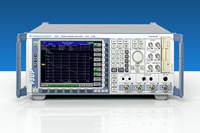All in one: The R&S FSUP combines a spectrum analyzer up to 50 GHz with a phase noise tester

When measuring phase noise, the R&S FSUP compares the "signal source" DUT with a reference source. The R&S FSUP can use external as well as internal references for this purpose. In addition, the user can select the source for regulating the required 90° phase offset on the phase comparator. If desired, the ideal settings for the measurement are selected automatically by the instrument. Together with other measurement parameters such as bandwidth, filter type and number of averages, the offset frequency range is also easy to configure. At an input frequency of 640 MHz and a frequency offset of 10 kHz, the phase noise value of the R&S FSUP with an internal reference source is -136 dBc (1 Hz) and at 10 MHz frequency offset -165 dBc (1 Hz). The R&S FSUP-B60 option provides the signal source analyzer with two parallel receive paths. The symmetrical structure allows a cross-correlation between the two paths up to a maximum frequency of 8 GHz. The R&S FSUP can thus eliminate the uncorrelated inherent noise of the internal reference sources. This improves the dynamic range by up to 20 dB, depending on the number of averages. The phase noise tester can record the level or the frequency of the signal source as a function of time and thus display settling and switching processes at high-frequency sources with high resolution. Thus, the instrument is also able to precisely analyze the behavior of signal sources in the time domain. To measure phase noise or to record VCO tuning characteristics or how the level and frequency vary as a function of the supply voltage, extensive settings of the oscillator's supply and tuning voltage are necessary. The R&S FSUP provides two independent, extremely low-noise DC supply outputs, a negative supply voltage and two tuning voltage sources for this purpose.
